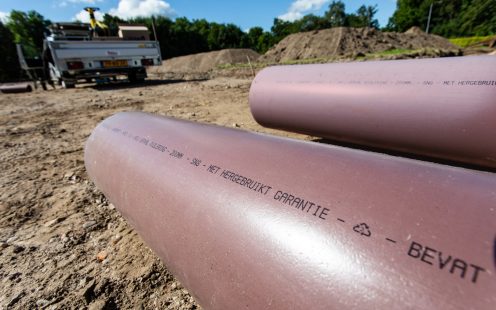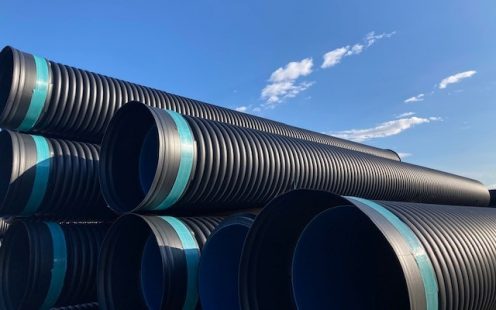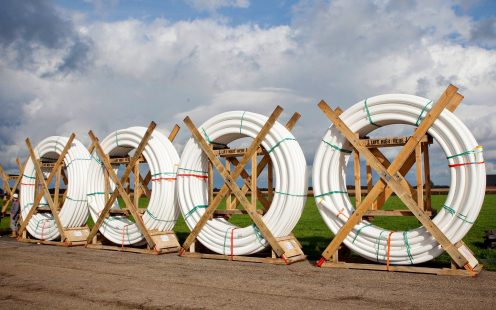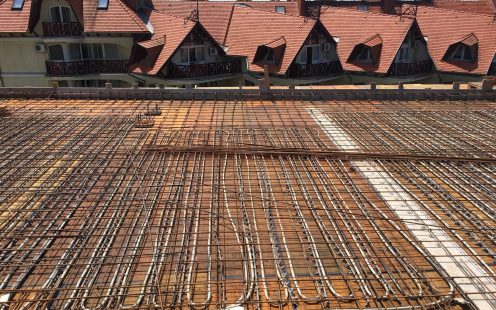Reduce, Reuse, Recycle: Let’s Transition Toward A Circular Plastics Economy
The three waste-management Rs have been commonly labeled as the pillars of sustainable development. However, to transform our economies from linear to circular, words must be turned into measurable actions, spearheaded by every player in the plastics industry. As one of Europe’s leading players, we are proud not only to meet the European sustainability targets but also to go above and beyond them.
.jpg)
Thanks to a combination of clearly set sustainable development goals at the corporate level and the genuine commitment and innovative capacity of our local teams, Pipelife has been setting the bar high for its peers when it comes to environmental responsibility.
"It's our duty to provide piping solutions that actively contribute to a safer and healthier planet. We won't get a second chance with the environment, so we hope that with our goals, we can set an industry example and make our world a better place to live by reducing overall environmental risk," maintains Pipelife International Head of Research and Development and Sustainability, Zoran Davidovski.

Increasing the Uptake of Recycled Materials in Production
Currently, less than 30% of Europe's plastic waste is collected for recycling. While new sorting approaches and technologies are raising the availability of good quality recycled materials, the bias regarding the properties of products made from recycled plastics is still present.
The EU Action Plan for the Circular Economy envisions recycling 55% of plastic packaging waste by 2030. Our R&D teams have been extensively studying and testing how to increase the use of recycled materials in manufacturing while maintaining the high quality that customers are expecting from Pipelife.
"It is still widely believed that recycled materials have unfavorable or inferior properties, but we can prove that this misconception is no longer valid," asserts Hielke Hoextra, Application Development Manager of Pipelife, "You can have highly reliable products made from recycled plastics. Of course, you need to test such materials very carefully, but it is possible to do that."
Over the past eight years, Pipelife has doubled the use of recycled materials in production, reaching 117.8 kilograms per ton in 2022. With several more products made from recycled materials currently in the pipeline, the number is expected to grow even further in the future.
- Last year, Pipelife Poland launched a new stormwater attenuation and soakaway crate system Stormbox E made from 100%-recycled material. The new product has been a success, gaining a lot of attention locally and in the neighboring markets, especially from clients committed to sustainable construction.
- In 2021, Pipelife Netherlands introduced Durofort — the first 100% recycled PVC wastewater and stormwater pipe in the national market. Durofort pipes are made from hard PVC extracted from plastics collected in the Netherlands. Recycling locally collected waste has additional benefits, such as strengthening local economies, reducing fuel consumption and associated CO2 emissions that arise from transporting recyclable materials over long distances.
- For several years, Pipelife Bulgaria has been selling corrugated pipes for non-pressure waste- and stormwater applications made from 100%-recycled PE. The local team worked in close cooperation with R&D to stringently test materials from various suppliers and find the ideal recycled PE that would ensure high ring stiffness. The product is successful not only in the local market, but also in Greece, Romania, Serbia, Montenegro and Macedonia.
.jpg)

Introducing Next-Level Reusability
Just a year ago, Pipelife reached the target of 90% of our products being recyclable and/or reusable. Today, we are proud that the figure has reached 99% of all our products. By 2023, all new Pipelife products will be 100% recyclable or reusable.
- The flexible composite pipe systems produced by Pipelife's brand SoluForce are made for the most demanding applications like high-pressure hydrogen transportation. Reusability is a key advantage in the energy sector, saving raw materials and reducing environmental impacts. The latest tests show that there is no degradation of SoluForce pipes even after 100,000 coil-uncoil cycles.
- Pipelife Norway has developed an innovative cable protection system, Protectline. Serving for 100 years, Protectline ducts allow extracting power cables — which happen to have a shorter service life — and pulling through new ones without repeated digging, which greatly reduces emissions and environmental disturbance.

Reducing Waste and Prolonging Product Life
Up to 80% of the environmental impact of products is determined in the design phase. It is, therefore, crucial for plastics manufacturers to plan for a sustainable life cycle for all products right from the start. By supplying top-quality products with an estimated service life ranging from 50 to 100 years, Pipelife saves resources, minimizes emissions and reduces plastics in landfills.
Apart from continuously increasing the quality and service life of its products, Pipelife has been also introducing systems that help minimize waste in other key industries, taking a step further when it comes to waste reduction.
- Pipelife’s prefabricated solutions for the construction sector allow saving around 20% of the piping material and reducing CO2 emissions due to decreased transportation. Every prefab system is designed and manufactured according to each project’s exact needs at the factory, offering a solution that considerably minimizes construction waste while also reducing installation time, costs and error risks.
- Pipelife Norway and Pipelife Sweden are now offering fossil-free PVC piping solutions to their clients. The ethylene necessary for the production of such pipes is extracted from biomass waste from the forestry industry. According to our raw material supplier Inovyn, the overhauled extraction process not only allows turning waste into a valuable resource but also has 90% lower CO2 emissions compared to conventionally produced PVC pipes.

Achieving Wider Impact
Over the past decades, plastics have been largely seen as a single-use commodity, with around 26 million tons of plastic waste generated in Europe each year. Nowadays, we have the technologies and the knowledge to step by step turn a circular plastics economy into reality. To make a greater impact, all players in the plastics industry need to come together and work toward meeting the goals set at the European level.
“By embedding the principles of the circular economy in our value chain, Pipelife preserves resources, minimizes waste and reduces CO2 emissions, supporting the goals of the European Green Deal. Close cooperation between the actors, high production standards, clear sustainability targets and tangible actions have contributed to our solutions’ success while raising the awareness of both the potential and the possibilities that a circular plastics economy can offer,” summarizes Harald Schwarzmayr, COO Wienerberger AG, Region West.
Find out more about our sustainability commitments
Get in Touch
Please choose your preferred way to get in contact with us. We will get back to you as soon as possible.
Fill our form